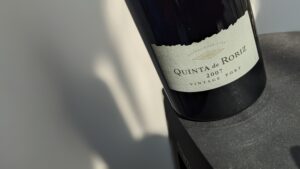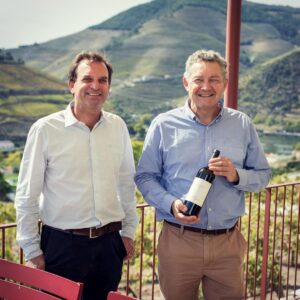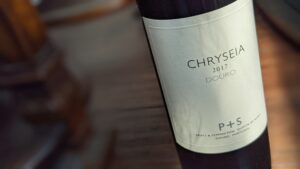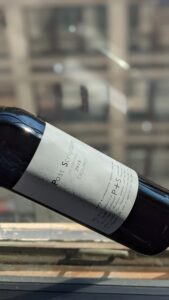In 1882, when Andrew James Symington first traveled from Scotland to Porto, the second largest city in Portugal, it would not only become a new adventurous chapter in his life but it would be the beginning of the legacy of one of the greatest Port wine families in Portugal. Andrew initially joined the Port house Graham’s which was owned by a Scottish family before going off on his own. It would be a lesson in perseverance because although sweet fortified Port wines would have bouts of extreme popularity with the British, as England had on and off economic wars with the French – their main supplier of wine, the steep slopes of the Douro Valley in northern Portugal, where the vineyards for Port are located, were treacherous to work as well as treacherous to travel to and from as there was no infrastructure built and so getting the barrels of wine to the main port cities such as Porto, so they could be shipped to England, became a momentous achievement each time the barrels made it unscathed.
It speaks to the adventurous spirit of Andrew that he stayed and luckily for the world of Port that remarkable attribute was passed on to four future generations of Symingtons that would not only carry-on his legacy but expand upon it to produce some of the most sought after fortified Port wines, as well as excellent non-fortified red wines from the Douro Valley.
Andrew James Symington eventually bought the Port house Warre’s; the next generation of Symingtons acquired Dow’s and then the next bought Graham’s and finally the current generation in charge acquired Cockburn’s and so each generation has helped to add to what is considered today a Port family dynasty where one out of three bottles of “really good Port sold worldwide” belongs to the Symington family, according to the current CEO of Symington Family Estates, Rupert Symington.
Part of the Symington portfolio includes the cherished estates of Quinta do Vesúvio and Quinta de Roriz with the former still using the centuries-old method of treading the grapes in granite stone tanks called lagares and the latter bought in partnership with Bruno Prats, former owner of the legendary Château Cos d’Estournel in Bordeaux. These estates are not only revered for their Port wine but for their outstanding non-fortified red wines as well as each of these estates express a special sense of place and a multitude of complexity which has helped build the reputation of the Douro as a great red winemaking region.
Quinta do Vesúvio and Quinta de Roriz
The Douro Valley has come a long way since the Symington’s legacy was first established as roads were constructed and dams were built which allowed much more activity on the river in regards to getting wine barrels to port cities as previously only the rabelo flat-bottomed boats were able to handle the shallow waters of the Upper Douro. But Rupert Symington remembers his father James talking about making Port as recent as the 1960s and even at that time the remote farms in the Douro did not have electricity as the places outside the main towns only just received electricity in the 1970s and so the Symington Port wines were made by using candlelight and gaslight as well as all the wines having their grapes crushed by an old traditional practice of locals stepping on the grapes in sync with music while it fermented into wine; the foot trodden practice for the most part is no longer practiced with an exception of a few special bottlings of Port or at a couple of wineries such as Quinta do Vesúvio. But as time has gone on more modern equipment has made it possible to raise the overall quality as well as make top quality non-fortified red wines possible that was also assisted by understanding the native grape varieties and various types of soils, aspects and micro-climates of the various vineyards in the Douro. Yet the painstaking process of building and maintaining dry stone wall terraces carved into the foothills of the mountain ranges are still a vital and costly part of grape growing in the Douro Valley.
Rupert’s cousin Charles Symington, who is head winemaker at Symington Family Estates, argued that they have the “most expensive grapes in the world” to grow considering the extremes of temperatures, which can go from freezing in winter to 100 degrees Fahrenheit in summer, low rainfall, low yields and large amount of manual work, as it is nearly impossible to mechanize any aspect in their vineyards, all add up to a huge overhead just for the viticulture work alone. The Symington family has even gone as far as using drones that carry infrared thermal cameras that can assess the vigor of their vineyards which helps them to improve the way they plant their vines, as there are several native red varieties that vary in their preference in altitude and direction as west, north and east facing vines can be achieved in the curved terraced vineyards of the Douro, and it can also inform them of when plots will ripen. Although many of the different grape varieties play an important role there are no two more important varieties in the Douro, according to Charles, than Touriga Nacional and Touriga Franca and he further noted that the Quinta do Vesúvio and Quinta de Roriz estate wines beautifully illustrated how well these two varieties complemented each other.
Touriga Nacional has good freshness, acidity and structure with spicy notes; alternatively, Touriga Franca does not have as much acidity yet has softer tannins and a lovely floral note. Simply put, “Touriga Nacional and Touriga Franca are the Cabernet Sauvignon and Merlot of the Douro,” explained Charles.
Quinta do Vesúvio and Quinta de Roriz blends rely heavily on these two varieties but interestingly, these estates are located in two different sub-regions of the Douro Valley. The Douro has three sub-regions but two of them are best known for quality wine: Cima Corgo and Douro Superior. The Quinta de Roriz estate is located in a sub-region of Cima Corgo, in the central area of the Douro Valley, where most premium Port originates within the classic schist soils yet in the Roriz estate there is a presence of tin and gold tailings from the old mines that give a “distinctive minerality”. The Quinta do Vesúvio estate is located in the Douro Superior sub-region, which is the most eastern area that actually shares a border with Spain and it also has porous schist soils over granite bedrock yet it is the driest and hottest of the sub-regions and although proximity to the Douro River, plantings at high altitudes and orientation of the vines helps to bring balance to the grapes, Vesúvio will many times display more power in its wines.
Heart Belongs to Adopted Home
These two estates are precious to the Symington family as they really represent their evolution from merchants to wine producers to finally vineyard growers as well as their generational commitment to the Douro Valley that includes investing in two historical estates that could have fallen by the wayside and been lost forever. The Symington family and their wine businesses in the Douro Valley have survived the Great Depression, two World Wars and a long stretch of economic and political instability in Portugal, and although at some moments in time it was as if they could barely keep their heads above water while holding these great Port houses over their heads figuratively, they made the sacrifices they had to make as the Douro is in their blood and it is vital that they keep the beautiful aspects of the Douro Valley alive while building a better future for everyone, whether be it their own family or the families of their workers, which is noted by their certified B Corporation status that commits to such intentions.
And the challenges of Covid have certainly thrown a great amount of uncertainty that has had intense ups and downs and no real end in sight but the Symington family seems to be made for such times as Rupert spoke about how difficult the times were after World War II and that his family had to sell off assets just to stay afloat. During that time, his grandfather didn’t take a salary for many years but they made it through and kept their roles as guardians of these vineyards – some of the most fiercely challenging vineyards in the world. But one of the most gripping challenges for Rupert in particular has been the loss of his father last year yet it only reinforces the importance to find ways to weather through this storm as he needs to do so for the next generation like his father did for him, especially considering his son Hugh just joined the family business a few years ago.
The hardships over these several decades have been balanced by the enormous amount of wonderful memories made as despite many of the Symingtons receiving their formal education in England, their hearts are in the Douro where their kids spend time with their grandparents during the summers and where there is a sense of community that is intrinsically part of their family; many of them admitting that although they feel privileged to be given the numerous opportunities to travel around the world, there is nothing like it when they can spend significant time in the vineyards and the cellars of the Douro Valley… that is home. A home where they have been a part of keeping a way of life, traditions and a viable economy going for over 100 years and hopefully for many more decades to come.
***This article was originally published on Forbes: https://www.forbes.com/sites/cathrinetodd/2021/12/04/two-great-wine-estates-that-are-part-of-portugals-wine-history/
The following are Port fortified wines from the 2007 vintage which was considered one of the coolest in recent history according to Rupert and Charles Symington.
2007 Quinta de Roriz, Vintage Port, Douro Valley, Portugal: Bright red fruit with sweet tobacco leaf and spice cake intermixed with fresh mint and candied cherry on the palate that finished with cigar and gravelly notes.
2007 Quinta do Vesúvio, Vintage Port, Douro Valley, Portugal: More wild herbs, forest floor on the nose and sweet fruit flavors on the palate with flavors of black forest cake lifted by eucalyptus notes.
Non-fortified premium red wines sourced from the above estates:
2017 Prats & Symington ‘Chryseia’, Douro Valley, Portugal: This wine is a blend of 75% Touriga Nacional and 25% Touriga Franca from the Quinta de Roriz and Quinta da Perdiz estates which are both located in the central Cima Corgo sub-region. A hint of that mint character alludes to that same quality found in the 2007 Port with dried flowers in the background and fleshy red fruit with round tannins that finishes with a smoky minerality – elegant and fresh.
2017 Symington Family Estates, Quinta do Vesúvio Tinto, Douro Valley, Portugal: 56% Touriga Franca , 41% of Touriga Nacional and 3% of Tinta Amarela. This is an estate red that comes only from the Quinta do Vesúvio property in the Douro Superior sub-region. Darker fruit right off the bat with black cherry preserves and a denser, deeper body with lots of concentration and a powerful structure that had hints of crushed rocks and lilacs on the finish.
The below wines are second wines to the above bottlings and they are real bargains retailing around $30 compared to the above wines which average around $90.
2018 Prats & Symington, ‘Post Scriptum de Chryseia’, Douro Valley, Portugal: 58% Touriga Nacional, 39% Touriga Franca and 3% Tinta Roriz (Tempranillo). A second selection of the Chryseia bottling. So much finesse and elegance with this wine and quite impressive considering the price; savory spice with cumin and earthy chili peppers that had hints of more uplifting anise seed notes with bright red cherries and hints of gravel undertones that had finely laced tannins.
2018 Symington Family Estates, Pombal do Vesúvio, Douro Valley, Portugal: 58% Touriga Nacional, 39% Touriga Franca and 3% Tinta Roriz (Tempranillo). This is the second wine of the Quinta do Vesúvio estate. This is a much bigger wine yet the silky tannins give a soft texture that is immediately pleasing with lush cassis and licorice flavors with lots of upfront fruit balanced by grounded notes such as wild mushrooms that then lift on the finish with hints of cloves and black pepper.
















